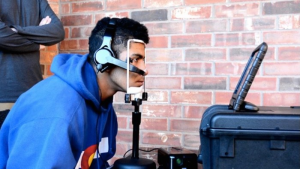EyeGuide Focus, a 10-second concussion detection tool, measures neurocognitive impairment quickly and reliably, following established research protocols to return quantifiable results, aiding athletic trainers and other healthcare providers in making informed decisions on concussions. It detects concussions in 10 seconds by recording and interpreting athletes’ eye movements. Focus can be administered immediately after a possible concussion. Just as important, it can be used to monitor recovery, providing accurate feedback showing the athlete’s daily progress from injury back to health.
Preliminary results from testing, conducted over the last few months, already indicate that athletic trainers and other healthcare professionals are happy with the speed and ease of use of Focus, as well as the quality of the data being returned. “Incorporating visual tracking abilities is the next step and is a good addition to our current protocols. The time efficiency is really nice, it’s a short test. It’s also easy to use,” said Kimber Rodgers, boy’s athletic trainer at Frenship High School in Wolfforth, Texas. EyeGuide Focus fills an obvious need in concussion detection and treatment. There are more than 3 million concussions yearly in the United States, enough for the Centers for Disease Control (CDC) to call it an epidemic. Many current detection tools cannot be used immediately after a possible concussion and often take far too long to administer. Some are also expensive, requiring schools on limited budgets to test only some of their athletes. EyeGuide Focus, however, is affordable. “Any school, of any size, that buys it will be able to test every athlete, every year, in every sport,” said Dr. Brian Still, EyeGuide Chairman. Although concussions can have very serious consequences, they’re also difficult to diagnose without the proper equipment. As a result, we’ve seen a variety of technologies aimed at helping athletic coaches to determine if players who have received knocks to the head are indeed concussed. One of the latest such systems, EyeGuide’s Focus, promises to deliver results in just 10 seconds. To use the system, each athlete begins the playing season by taking a test. This involves putting on an eye-tracking headset, positioning their face against an included chin rest, then watching a moving white dot on an iPad screen. As that dot moves in a figure-8 pattern, they follow it with their eyes. The headset records those eye movements, then sets them as that person’s normal baseline.
Later on in the season, should they get thumped on the noggin, their coach can immediately call them to the sidelines and administer another test. If their eye movements are significantly “sloppier” than their previously-established baseline, then the coach knows that neurological impairment is likely, and can get medical help for them as soon as possible.Additionally, when the player is first setting their baseline, their eye movements are compared to those of other players already stored in a database. If their movements are suspiciously less sharp than average, another test can be advised. In this way, players are discouraged from purposely fudging the baseline in order to avoid being taken out of play when a genuine concussion occurs later on. Later on in the season, should they get thumped on the noggin, their coach can immediately call them to the sidelines and administer another test. If their eye movements are significantly “sloppier” than their previously-established baseline, then the coach knows that neurological impairment is likely, and can get medical help for them as soon as possible. Additionally, when the player is first setting their baseline, their eye movements are compared to those of other players already stored in a database. If their movements are suspiciously less sharp than average, another test can be advised. In this way, players are discouraged from purposely fudging the baseline in order to avoid being taken out of play when a genuine concussion occurs later on. It is also reliable. According to Dr. Benedicto Baronia, a pediatric neurosurgeon and concussion clinic director, “the most common concussion symptom is attention impairment. Evaluating eye movement is a more accurate measurement of attention impairment than neuropsychological testing used by many concussion products. EyeGuide Focus is simple but reliable because it tests users’ eyes to see if they can visually keep steady, accurate attention on a moving object. If they cannot keep normal attention, then the failure to do so, given other factors, such as a hard hit in a football game, indicates possible neurological impairment.” EyeGuide Focus is currently in the final stage of testing and will be available for sports teams everywhere by summer 2016.
For more information please visit: www.eye.guide

